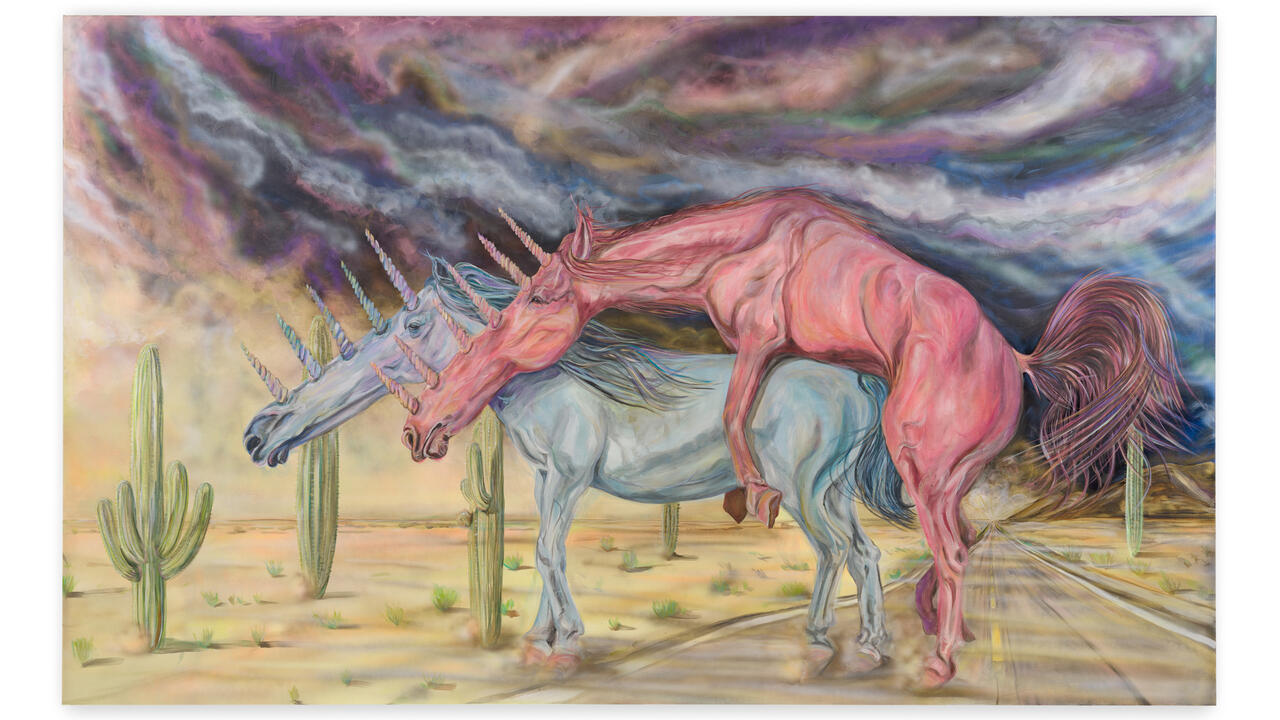Rochelle Feinstein
On Stellar Rays, New York, USA
On Stellar Rays, New York, USA

Words drip from a curtain: ‘HEARTB/ROKEN/DEARM/EMBERS/HARTI/SLAND/DEARW/HITEP/EOPLE/HEARTS/HAPE/
FEEDB/ACKL/OOP/FEMINISTIC/ORIGIN/ALIS/M’. The words, though, are broken, handwritten, a lamentation. The line breaks force me to re-read them. ‘DEARM/EMBERS’ scans as ‘dream embers’. ‘ORIGIN/ALIS/M’, with its dangling ‘M’, could be shorthand for ‘men’ cut off from their ‘origin’, while ‘ALIS’ reads as ‘allies’. In her show ‘Who Cares’ at On Stellar Rays, Rochelle Feinstein offers the dream embers of our present. Her curtain might be a shroud. The piece Ear to the Ground (2017) cuts the gallery in half, while the paintings in the show are all halves and doubles, diptychs and triptychs that capture the current sense of helplessness not just in politics or society, but in art too, when its ability to create change can seem limited. The show’s title, ‘Who Cares’, is both a question and statement, as in ‘who gives a damn’.

In Feinstein’s work, language often floats free and becomes an abstraction itself. The curtain also reveals the way the show comments on the human condition – colour (of both paint and skin) and the social realm, care and empathy – as well as on how these terms are set out for us. On either side of the curtain, colour wheels spin out of control in Off Color (2017) and the paired canvases Color Therapy (2015), begun during the first Black Lives Matter protests. In Color Therapy, the paintings’ colours bleed into each other and drip down the canvas; shards of a colour wheel point like missiles at the falseness of colour as code, science or even art. The work seems to collapse under the weight of a dark void at its centre, like a dying star.

The work in ‘Who Cares’ is mournful. Take H(e)art Island (2017), for example: it represents both love and a location. New York City’s Hart Island has a disparate history as a Civil War prison, a women’s sanatorium and a potter’s field, the last resting place of the lost or indigent, where some 850,000 have been buried. Their family members have been waging battle with the city for the right to visit. In its shades of slate, the painting could be maudlin. A stuffed and stitched heart lies on its side, sagging at the centre, mapped with crisscrossing dotted lines like paths or sutures. Here is loss, history and empathy in our emoji era where images can stand in for words and words are often emptied of their meaning. The painting’s companion piece, ZUI (Zoomable User Interface, 2017), has honed in so close to the map it’s collapsed, or become abstract.

Feinstein abstracts objects that are ‘enigmas’ to her (the word appears more than once on the curtain) in order to grapple with their meaning. As seen in ‘In Anticipation of Women’s History Month’, her 2016 European touring retrospective, she’s used feminism, politics, the work of other artists and even reproduction and abstraction itself as her starting points. In her 2011 show ‘The Estate of Rochelle F’, Feinstein plumbed mortality and the Great Recession as she broke apart, remade and reused her own work (and works other artists had given to her), as if the gallery were a garage sale. This process is personal and essayistic, often inflected with both anger and humour. Now the work is tackling darker subjects, and I keep thinking about ‘ORIGIN’ and ‘M’, those dangling men and a country. Today that ORIGIN and M – the Originalists, a large camp in the Republican Party, want to return to a literal reading of the US Constitution. Which again begs the question: Who Cares? Particularly in an era when care can be fleeting, professed with ease on social media but lacking real substance, while feeds cycle through news fake and otherwise, celebrity and punditry, protest and the personal.
Main image: Rochelle Feinstein, Who Cares, 2016, acrylic, cotton muslin on canvas, 127 x 127 cm. Courtesy: the artist and On Stellar Rays, New York; photograph: Kirsten Kilponen






















